The Ronald Duncan Collection contains a wealth of photographs of the Duncan family, their friends and areas of North Devon. In order to identify these photographs I recently travelled to meet Ronald Duncan’s daughter Briony Lawson at West Mill, Welcombe. Spending a few days in one of the most picturesque parts of Devon is undoubtedly a tough job, but I was up for the challenge.
My accommodation for the trip was at Home Farm Bed and Breakfast, run by friendly hosts Mike and Alison. Home Farm was previously owned by Ronald Duncan and remained the home of his wife Rose Marie Duncan after his death. Though the house has now been extended, it remains broadly as it was in Duncan’s time, along with the connecting Mead Farm which is now holiday cottages.
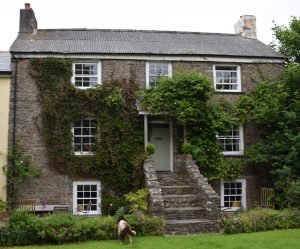
Home Farm today
My room was a small building at the bottom of the garden known as ‘The Old Dairy’. Though this may once have been true, both Mike and Briony reliably informed me that it more recently served as Ronald Duncan’s tool shed. Mike happily recalled the salvaged nuts, bolts and other assorted wonders he found hoarded there, some of which now take new life as part of a bird sculpture in the Garden. Down in the guest lounge it was lovely to see well-worn copies of Duncan’s books which had clearly amused scores of walkers on rainy days.
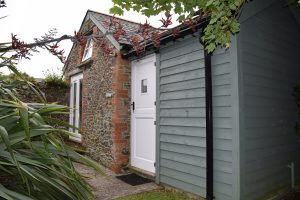
‘The Old Dairy’ at Home Farm, or Ronald Duncan’s shed!
Having arrived a little early I decided to take a trip down to Welcombe Mouth beach, a favourite beach-combing site of Duncan’s and the scene of many photographs of family picnics. Alison took one look at my Ford KA and warned me that I’d better not attempt the track down and should park near the Post Box at the top. Too busy staring at the scenery, I missed the post-box and carried on down the track. A few nerve racking minutes later I emerged to a dirt car park filled with 4×4’s and a stunning view out over the mouth.
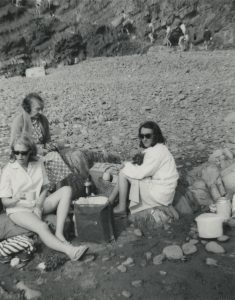
Briony, Mole and Bunny Duncan picnicking on Welcombe Beach c 1960s
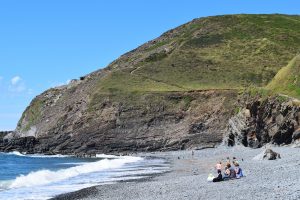
Welcombe Beach today
It’s clear why Duncan loved this beach. Its lack of accessibility means there were only a few people enjoying the scenery and dramatic ridges of rock rise up out of the sea and sand. Here and there someone had built a tower of stones and scattered rocks bore messages from visitors. It was easy to imagine that I might find the initials RD if I looked long enough. Round the corner a beautiful waterfall trickled down onto the beach and scattered around were bits of rope and sea-glass ready for any beach-combers.
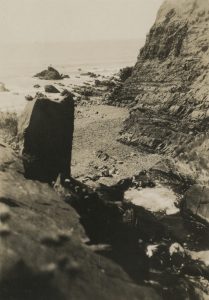
Welcombe Mouth from the top of the waterfall c late 1930s
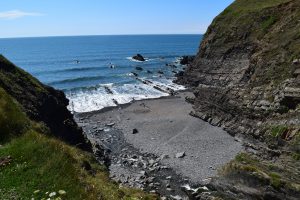
Welcombe Mouth from the top of the waterfall today
A little reluctantly I left the beach and attempted the steep ascent. Luckily my car is made of stern stuff and I managed to get up from the beach and down the steep track to West Mill without mishap. The valley was incredibly picturesque and Briony and Andrew Lawson were ready to welcome me warmly with a lovely cream tea. West Mill today is a far cry from the early photos in the collection. Its days without electricity and central heating are long gone and Briony remarked that she couldn’t imagine how the family used to survive there in the winter.
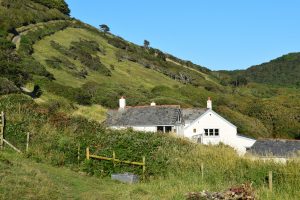
West Mill today
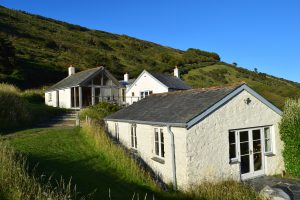
West Mill today
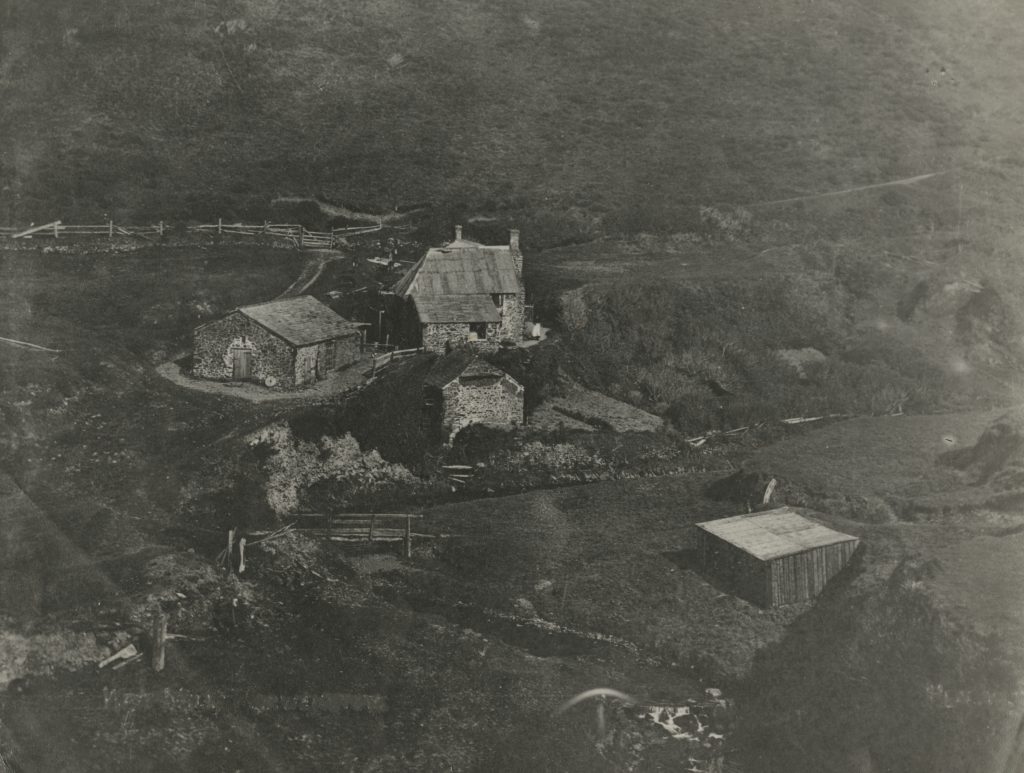
A view of West Mill and the surrounding Valley c 1930s
Considering the mound of photographs we had to identify I’m amazed at the pace at which we sped through them during the visit. Briony easily recalled the people, places, dates, and little anecdotes that brought them to life for me. The water wheel, lovingly restored by Duncan’s close friend Nigel Spottiswoode, has been converted to electric and is turned on for me to experience. Having read so much in Duncan’s autobiographies about the continual struggle to keep it working I’m glad that it still remains.
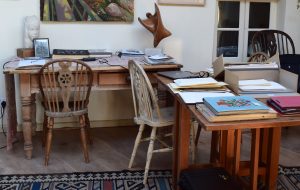
Work in progress – identifying the photographs from the Ronald Duncan Collection
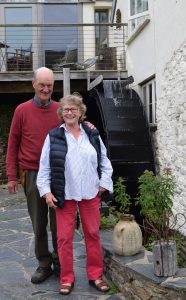
Briony and Andrew Lawson in front of the water wheel at West Mill
One evening I climbed the steep cliff to Ronald Duncan’s writing hut, overlooking West Mill and the valley on one side and Marsland Mouth on the other. It was only a five minute walk from the house, nevertheless I was sweating by the time I reached the top. I can’t imagine climbing up and down the cliff several times a day to write.

Exterior of Ronald Duncan’s writing hut overlooking Marsland Mouth today
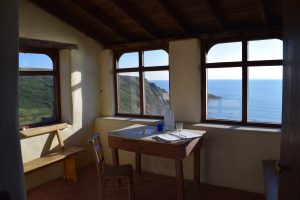
Interior of Ronald Duncan’s writing hut today
Originally an old lookout point, the hut was rebuilt by Duncan, who wrote his epic poem ‘Man’ there among other works. It has been maintained by the family and has information panels about Ronald Duncan and his work on the walls inside. The visitor’s book is a fascinating read and shows that the hut continues to provide shelter and inspiration to walkers. The view from the hut over the mouth was breath-taking, though its un-sheltered position must have made it a bleak, cold place to work in the winter.
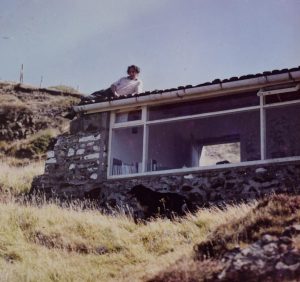
Ronald Duncan lying on the roof of his writing hut c 1960s
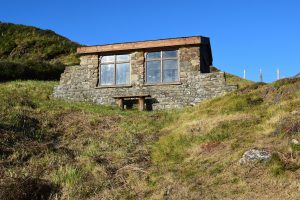
Exterior of Ronald Duncan’s writing hut today
On my last day I visited Docton Mill. Now open to the public as a garden and tea rooms, this lovely old house used to be the home of Mole and Bunny Duncan, Ronald Duncan’s mother and sister. Briony and Andrew very kindly introduced me to the owners and I spent a pleasant couple of hours looking over old photos of Docton Mill with them and wandering round the beautiful gardens in an attempt to recreate the old photographs.
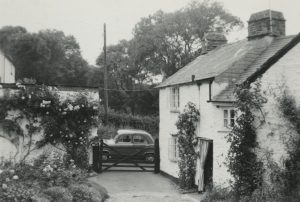
Docton Mill c 1950s
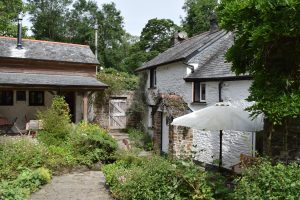
Docton Mill today
I left North Devon reluctantly with a greater understanding of Ronald Duncan’s life there and with an invaluable resource for researchers of the photographs in the collection.
More about the Ronald Duncan collection can be found here.